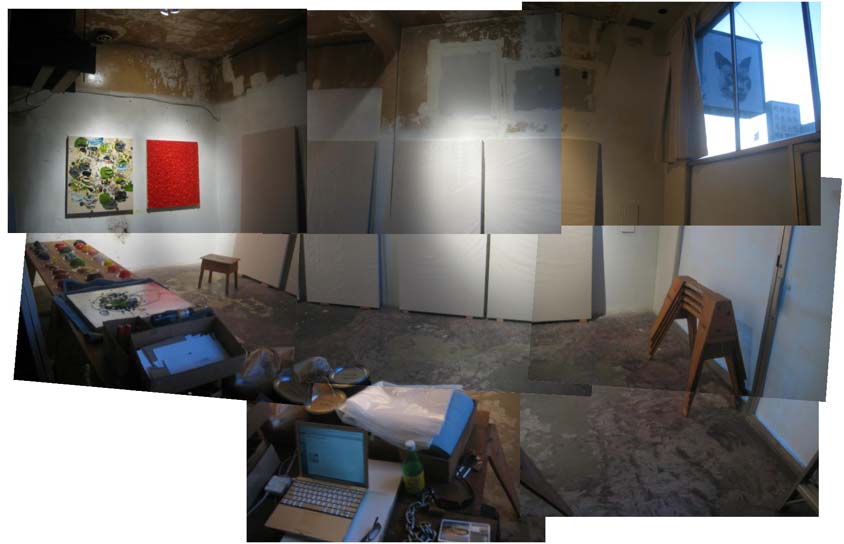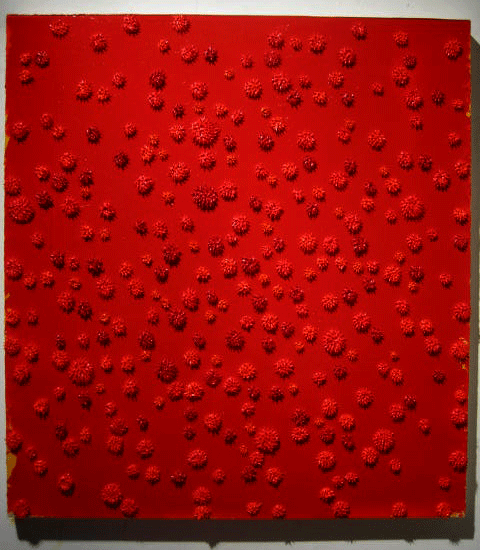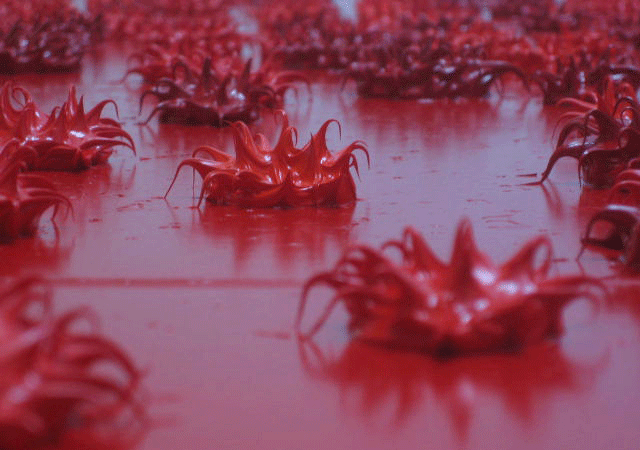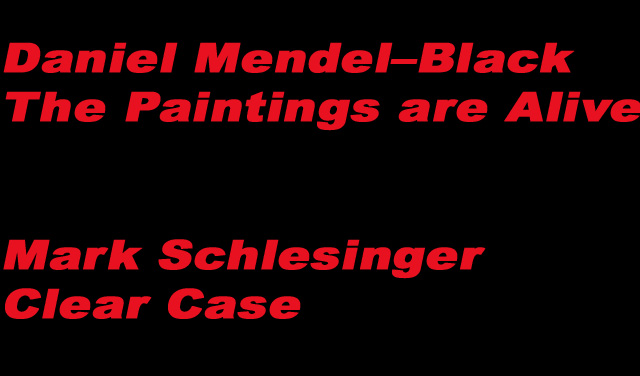December 28, 2006
Better/Longer/Differently.
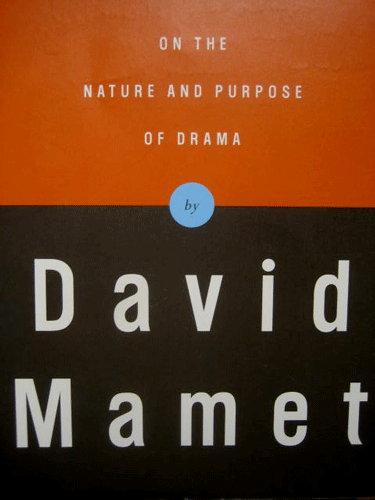
This just in, a book on drama from Mamet I found along the way.
Amazon's "One-Click" is a weakness of mine.
Here's the first section of Chapter One, "The Wind Chill Factor":
It is our nature to dramatize. At least once a day we reinterpret the weather -- an essentially impersonal phenomenon -- into an expression of our current view f the universe: "Great. It's raining. Just when I'm blue. Isn't that just like life?" Or we say:"I can't remember when it was this cold." in order to forge a bond with our contemporaries. Or we say:"When I was a lad the winters were longer." in order to avail ourselves of one of the delights of aging.
The weather is impersonal, and we both understand it and exploit it as dramatic, i.e., having a plot, in order to understand its meaning for the hero, which is to say for ourselves.
We dramatize the weather, the traffic, and other impersonal phenomena by employing exaggeration, ironic juxtaposition, inversion, projection, all the tools the dramatist uses to create, and the psychoanalyst uses to interpret, emotionally significant phenomena.We dramatize an incident by taking events and reordering them, elongating them, compressing them, so that we understand their personal meaning to us -- to us as the protagonist of the individual drama we understand our life to be.
If you said, "I waited at the bus stop today." that probably wouldn't be dramatic. If you said, "I waited for a long time today," that might be a little more dramatic. If you said, "The bus came quickly today," that wouldn't be dramatic (and there would really be no reason to say it.). But you might say, "Do you know how quickly that bus came today?" --and all of a sudden, we're taking the events of life and using dramatic tools.
"I waited half an hour for a bus today," is a dramatic statement. It means: "I waited that amount of time sufficient for me to be sure you will understand it was 'too long.'"
(And this is a fine distinction, for the utterer cannot pick a time too short to be certain that understanding is communicated, or too long for the hearer to accept it as appropriate -- at which point it becomes not drama but farce. So the ur-dramatist picks unconsciously, and perfectly, as it is our nature to do, the amount of time that allows the hearer to suspend his or her disbelief -- to accept that the half-hour wait was not outside the realm of probability, yet is within the parameters of the unusual. The hearer then accepts the assertion for the enjoyment it affords, and a small but perfectly recognizable play has been staged and appreciated.
"This is only the third time in NFL history a rookie previously benched with what was believed to be a serious injury returned to rush for more than 100 yards in a post season game."
That NFL statistic, like the wait for the bus, takes the unremarkable and frames it to afford dramatic enjoyment. The ejaculation "What a run!" is given a statistic to allow us to savor it better/longer/differently. That run is assigned the dramatic weight of the incontrovertible.
Take the useful phrases "you always" and "you never." In these we reformulate the inchoate into the dramatic. We exploit the utterance and give it dramatic form, for some personal benefit. We might gain transcendence over our significant other, as in the case of "you always" and "you never." We night open a dinner table chat with a nice topic of conversation: "I waited half and hour for a bus today."
In these small plays we make the general or the unremarkable particular and objective, i.e., part of a universe our very formulation proclaims understandable. It's good dramaturgy.
Bad dramaturgy can be found in the palaver of politicians who have somewhere between nothing and nothing much to say.They traduce the process and speak, rather, of the subjective and nebulous: they speak of the Future. They speak of Tomorrow, they speak of the American Way, Our Mission, Progress, Change.
These are mildly or less mildly inflammatory terms (they mean "Rise Up", or "Rise Up and Rush Around Boldly") that stand in for drama. They are placeholders in the dramatic progression, and they function similarly to sex scenes or car chases in a trash film -- they are related to no real problem and are inserted as modular treats in a story devoid of content.
(We may assume, similarly, that as Democrats and Republicans respond to each other's positions by screaming "scandal," their positions are essentially identical.)
We can see the natural dramatic urge in newspaper quotes of a film's grosses. The dramatic urge -- our impulse to structure cause and effect in order to increase our store of practical knowledge about the universe -- is absent in the film itself, but emerges spontaneously in our proclamation of a naturally occurring drama between films. Just as, when we have exhausted our interest in Zeus, we spontaneously create the pantheon.
Some say the land is growing hotter. No, say the others, it is not and your senses are at fault. and, so, we have the wind-chill-factor. Since we cannot wish away our anxiety about climate change , we dramatize it, transforming even that (one would think) least personal, most scientific measurement, the temperature, exactly as we dramatized our wait at the bus stop.
I need to feel maligned, so I say, "And the damned bus was One Half Hour Late!" I need to feel other than
anxious, so I say, "The temperature may be hotter than normal -- but, with the wind chill factor..."(Please note that this is a rather elegant dramatic device, for the wind does not blow at the same speed all the time, and can be tempered by one's position in or out of its path. The "factor" allows one to suspend one's disbelief for the pleasure it affords.)
When the contents of the film or the decision of legislature do not satisfy (i.e., do not still our anxiety, do not offer hope), we elaborate the arid action into a superstory -- just as the creation myth is supercesed by the pantheon, internecine battles replacing primordial being/nothingness anomie. (If we watch any television drama long enough, the Clinton White House, or Hill Street Blues, or ER, we will see the original dramatic thrust give way to domestic squabbles. After a while, the new is no longer new, and we require drama. It's how we perceive the world.)
Our survival mechanism orders the world into cause-effect-conclusion.
Freud called music polymorphous perversity. We take pleasure in the music because it states a theme, the theme elaborates itself and then resolves, and we are then as pleased as if it were a philosophical revelation -- even though the resolution is devoid of verbal content. Like politics, like most popular entertainment.
Children jump around at the end of the day, to expend the last of that day's energy. The adult equivalent, when the sun goes down, is to create or witness drama -- which is to say, to order the universe into a comprehensible form. Our sundown play/film/gossip is the day's last exercise of that survival mechanism. In it we attempt to discharge any residual perceptive energies in order to sleep. We will have drama in that spot, and if it's not forthcoming we will cobble it together out of nothing.
Sounds familiar.
December 24, 2006
Happy Holidays Everyone!

We're in Michigan near Detroit and Ann Arbor to spend a few days with our niece and nephew... the best Christmas is one centered on kids after all.
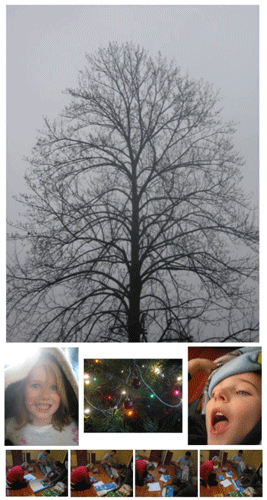
All the best to you all, dear blog readers!

Happy Holidays!
December 20, 2006
Ubiquitously Unmentionable
Shortly after grad school, after the fall of the Berlin Wall, after the fall of continental theory and the rise of painting and everything else in the beginning of the dot-com boom, I remember a general reluctance to use the term "post-modern" and the language that configured it--even or especially in a critique of it.
I remember a self annointed grand pooh bah artworld intellectual announce grandly in a ChinaTown bar at the peak of the dot-com boom that "...no one mentions the word "post-modernism" anymore...".
As recently as last month I managed to collar a reasonably intelligent young curator--newly minted from grad school-- in my effort to understand the thesis of her exhibition, I used the term "post-modern". I was promptly and tersely instructed that that word is no longer used in the artworld anymore.
I guess the folks at the Economist Magazine didn't get the memo:
...The pomos wrote about pretty much everything in society?literature, psychoanalysis, punishment, sociology, architecture?except economics. This was perhaps odd, given that they emerged during the longest economic boom in European history and the birth of the consumer society. The only pomo who tried, far too late, to come to grips with this irony was Foucault. In one of his last lectures, in January 1979, four months before Margaret Thatcher came to power in Britain, he shocked his students by telling them to read the works of F.A. Hayek if they wanted to know about ?the will not to be governed?. Hayek was the Iron Lady's guru. Surely there was nothing post-modern about her?But Foucault had belatedly spotted that post-modernism and ?neo-liberal? free-market economics, which had developed entirely independently of each other over the previous half-century, pointed in much the same direction. One talked about sex, art and penal systems, the other about monetary targets. But both sought to ?emancipate? the individual from the control of state power or other authorities?one through thought and the other through economic power. Both put restoring individual choice and power at the hearts of their ?projects?, as the pomos like to describe their work.
Niches and fragments
Liberal economics has probably had a greater role in transforming capitalism than a few French Marxists using long words. But the pomos' ideas have had a certain influence, seeping into common consciousness through the lecture halls and student campuses. Many brands have been developed by people who were brought up on the idealism of the 1960s, post-modernism's heyday. Entrepreneurs such as Virgin's Sir Richard Branson and Body Shop's Anita Roddick bring an emancipatory, anti-corporatist tilt to their business. Modern marketing has consciously co-opted the tools of post-modern ?discourse? to sell more stuff. Brands such as Nike explicitly adopt rebellious attitudes in their advertising campaigns. Thus capitalism employs the critique that was designed to destroy it....
Notes:
1. If you can't use a word for a phenomena, you can't critique that phenomena.
2. Nice to see Hayeck's name dropped, especially in this context.
3. Bear in mind that the term "liberal economics" in Europe means something in the direction of the free market in the United States, Milton Friedman stuff.
4. I tend to define the post-modern era as that which has reigned since the end of the fifties with the emergence of Pop Art, through the permutations of the isms: Minimal, Conceptual, all dribbling out into this very day.
5. Note #4 hinges on note #1. We won't be able to move on until we critically overhaul that past fifty years of cultural production.
6. We need to move on.
December 15, 2006
December 11, 2006
Hanoi Street Crossing
No rules? I disagree slightly. There are many, many, many small contracts negotiated individually and administered in rapid succession.
Last Day Saturday
Aaron and I went in solo this day as our ladies went shopping with our hosts Harry and Leah. I had mixed feelings about it since Sharon's dad (whose house in which ae are so fortunately enjoying their generous hospitality) Harry is a fascinating gentleman who has lived quite a life. He escaped Romania walking and hitching across to Palestine, where he met his wife Leah. He participated in the movement for Independance and the formation of the state of Israel. They immigrated to French Canada and established a home building development company that was tossed in the rocky waves of the seccessionist movement, which drove him to find eventual success in Florida. Plus, he sports a remarkable counteance that reminds me of Jakie Mason fused with Frank Sinatra, leavened by a dash of Bhudda.
Europe between the wars. Israel before, after the (re)creation. Geopolitics. America and Europe. Canada. French Canada. Toronto. The USA. Florida. Real Estate Architecture and Development. Immigration, struggle and life. And life, yes life: Judaism.
Tough competiton for the fair, I'd say.
But we had yet to see the big fair. The big fair. We didn't plan it this way, but we saw worlds of artwork moving up the economic scale. We found ourselves noticing the quieter room and the softer surface underfoot. The bars, lounges and VIP rooms became roomier and more sophisticated. Security got intense, with repeated and pointed prohibition of filming anything inside either moving or still. The guards didn't seem to know what to do about cell phones. OK, I thought, no shots of the interior for the blog, then.
I went in to find Tomio Koyama, my gallery in Tokyo and my next show. Sorry folks, but I didn't wield the photographic instrument to capture an image for the blog. The visit went down without me taking out the camera as I tried not take an exploitive relation to the experience. I'm trying to keep it real, people.
I did feel compelled to steal a shot of Shintaro Miyake's performance at booth A-2, a gallery called Gerhardsen (I panned over to get a look at a Mathew Ritchie along the way):
That's right.
A beaver.
A beaver costume, that is. Shintaro underneath the costume is quite a dude: grown up, hirsute and burly. Think what you like and as you will but I take note that Shintaro's performance bubbles a childlike universe out of his drawings, through his costume and to the children ("of all ages") in the audience. Adults might not "get it" --if there is an "it" there-- but enchantment is the key to the realm with the anime aura after all.
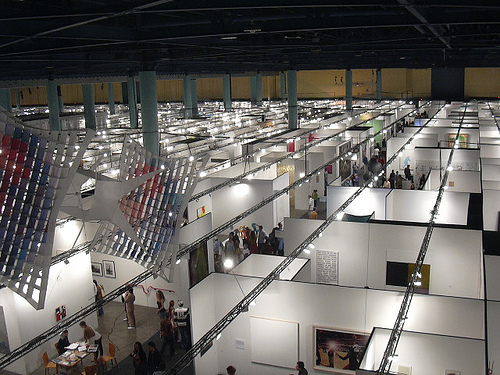
But that's about all of the images I took of the interior of the big fair. For those of you who want a more documentary approach, check out Paddy Johnson's blog for a more journalistic exposition, good stuff. I found his picture snapped through a window from the sidewalk via Tom Moody's blog, and it looks like he too (P. Johnson) was policed by the prohibition against photography.
Tom Moody referred to the big fair in the pic as the borg, but I think all the fairs were identical schematically (not in terms of a hive, but in terms of what I would assert as a kind of humanism of the marketplace) and different only in the degree of dollars expended. What struck me about art fairs in general was that a fair is a literal compression of all of the activity in mounting a conventional gallery month long exhibit: the installation, the reception, the transaction, the deinstallation and shipping, repeat... all of this hubub one can see in the videos here... and the upshot is that contemplative space itself is squeezed out.
B'bye.
The action in the container galleries by the beach were no less mercantile and if there was a reclamation of contemplative space in the volume of a shipping container, I can't see it. The galleries who expended treasure to show artwork there were keen on doing more than breaking even. From fair to fair as you work up the price point ladder, artwork got a a little more of a bubble of contemplative space... a smidgeon, but it was there. Money can't buy you love, but maybe it can buy quality time for the art we make (we, with our lives on the line-- time=money) in our own art studio "cube farms" (wink nudge wink, T.Moody).
Aaron flagged the recent Bad at Sports podcast episode #63 for a lively discussion with longtime gallerist Rhona Haffman for topics relevant to art commerce and art fairs. Highly recommended. It starts off with a characteristic wringing of the hands over the fate of Chicago art after suffering the demise of the Chicago Art Fair and the once very good magazine, the New Art Examiner. I don't blame them for wincing from the sting, but the constant worry about the regional aspect of Chicago art isn't good for them. Hoffman's characterization about LA's regional signature as one about light seems severely dated to me as well. Sure, that was the box artists worked in for some time, but after Schimmel's 1992 MOCALA show "Helter Skelter", an appropriately dark underbelly was added to the sunny side up aspect of LA (an aspect that was always there, if you've read or seen "Day of the Locust" or "Ask the Dusk"). It was as if we added a south to a north and thus invented a compass that liberated us from the straightjacket of blue sky LA typecasting. Chicago could use its' own compass. I like the way Bad at Sports flies their freak flag but the constant Chicago refrain is getting sad.
(And therefore a note for the citizens of Miami: best to watch the gouging in local hotel rates, or you too will be crying in your beer. I heard that some hotel rooms were jacked up to upwards of $800!)
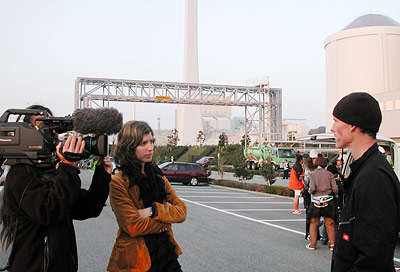
The finale for our final night in Miami was a screening for Alison Chernick's "No Restraint", which is an exquisitely subtle documentary of the making of Matthew Barney's "Drawing Restraint", his latest production. Treading between the edges of a vanity project and an exploratory documentary, Chernick maintains a gyroscopic detachment as Barney's support system (gallerists, magazines, curators, even his own father) eagerly yet bllindly demythologize the great artist that up to this point towered over New York. As the movie rolled, I thought about how the surrealists championed making the familiar strange and what happens when the strange is made familiar... about how we as an audience tend to project greatness on talent that dies young or what happens when hidden depths are plumbed with an unexpected ease... about all those oh so earnest bull headed half baked self indulgent symbol mongering artworks that train wrecked so appropriately in the surrounding studios in art school... about the difference between the work of Bjork and Barney, between the necessary figuration of musical rythmn and the difficulty inherent in the abstraction of floppily connected tropes... about others who owned similar materials such as Joseph Beuys' felt and fat and what difference lies therein... lots of thoughts.
Afterwards, it was time for drinks and dinner atop the Delano Hotel for the after party.
Dark shadows concealed alot of potential indiscretion from my camera and while the boys from Chinatown mucked about with taunts and bravado, I asked Mat Chambers to give me a tour of the skyline of this city where he went to school. Miami is a pretty nice city, in the final analysis. If I were a young artist, I would consider making my base there, a place one could grow into and become part of. There's a lot of building going on and there are many empty lots and signs on buildings for lease or rent. The art fair may go bust like Chicago but there is a basic matrix of art schools, collectors, galleries, a full flavored local Cuban culture (and the prospect of Havana going Vegas after Castro passes) and cheap rent in a fun context with a proximity to New York that's appealing.
I flew in with a canned idea: that the immensity of scale would torque our art world in problematic and interesting ways.. and I still think this is the case, but without hype and drama. We all can deal with the tsunami after all, even though it will change us in ways we cannot yet foresee. The marketplace has changed what art used to be, and maybe that isn't so bad. The dynamic of change isn't over yet to be sure, our new normal. Mega multi modal art fairs is a phenomena in transition. All the better for us artists and culture workers to keep on our toes.
Yea, Miami is a place I'd like to see again.
December 9, 2006
After the Museum
Our eyes glaze, the multitude burns.
One thought along the way: There's so much art, so many artists... why can't we create a robot to look at it all and report back with a summary later wile we go to the parties?
Just kidding of course. Scale and it's discontents.
Aaron and I talked about the problems of scale and that the museums are apparently no longer capable of doing their job: telling the story of art. The story has gotten bigger than the instituioinal level can cope with. What to do? Aaron suggested this article linked from Laura Lark:
...I am curious about the art analog to this growing phenomenon of mass volunteer cooperation, or crowdsourcing.Jeff Howe introduced the term crowdsourcing in his June 2006 Wired Magazine article, ?The Rise of Crowdsourcing? to describe a new form of corporate outsourcing to largely amateur pools of volunteer labor that ?create content, solve problems, and even do corporate R & D.? Examples of online enterprises successfully built on crowdsourcing are abundant: EBay?which enlists users to stock a marketplace, consume from and police it; Amazon?which relies on users? product reviews to sell to like-minded shoppers; and the more recent Threadless?a company that prints and sells user-generated t-shirt designs based on popular vote. In his 2002 book Smart Mobs, Howard Rheingold called these consumer-driven ratings ?reputation systems? and indicated that for the moment (barring radical changes to telecommunications law) consumers have the power to create what they consume....
...With the cooperative intention of projects such as these, crowdsourcing as a method of artistic production appears to be heir to the throne of 1960s and 70s happenings and participatory art. These artists are less interested in sole authorship and visibility--they are phantom captains2--and more in distributed creativity, gift economies, and other models that disrupt how we think about and assign value to art. As evidenced by grid computing programs like SETI, even the biggest supercomputers cannot compete with half-a-million networked home machines. And Howard Rheingold predicted in Smart Mobs that ?key breakthroughs [in technology] won?t come from established industry leaders, but from the fringes, from skunkworks and start ups and even associations of amateurs. Especially associations of amateurs.? Perhaps breakthroughs in art will come from the skunkworks, the noodlers, and the untrained crowd, too.
Sounds good to me.
Miami Art Fair 2006:
(Here's a bunch of videos, raw data sans frill or analysis, blogging on the run.)
Scope Entry Sequence.
Deeper into Scope.
UPDATE: Jean Milant, the owner of Cirrus Gallery, (the tall one seen here in the video chatting to a collector) sent me a couple pics of the booth here and here. Justin Moore was assisting, his work (all sold quickly) can be see on the left wall as we enter the space.
Pulse Entry Sequence.
Out in the street to show you the crowd level and general hubub.
NADA entry sequence.
Inside NADA.
More to come of course.
December 8, 2006
Henry in the House
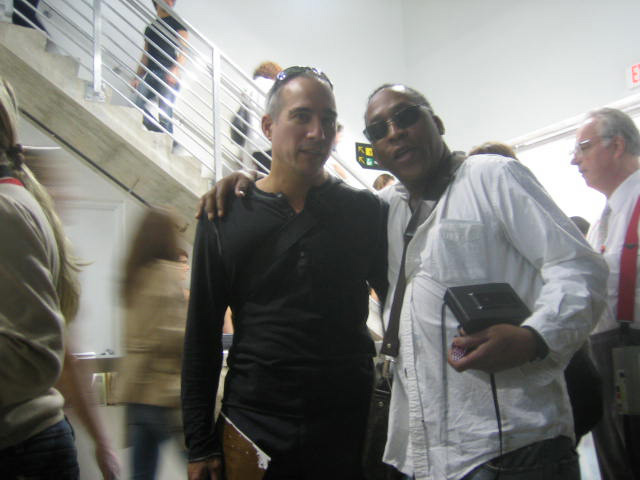 Blog posting on the fly: we found Henry Taylor at the Rubell Collection's Red Eye Show.
Blog posting on the fly: we found Henry Taylor at the Rubell Collection's Red Eye Show.
A slew of fotos to come asap.
December 7, 2006
Ahora
We're in Miami!
Already, we got lost striahgt out of the airport, taking an unwanted thourlong detour thru "Alligator Alley" on our way to Del Rey Beach. We're staying with our good friends Aaron and Sharon at her family's house north of Miami.
Stephanie is shopping and I found a wifi signal, so happy am I. But I can't find my cable to upload pics to show you all right now.
We were at the Rubell Collection show, where I bumped into Henry Taylor, Chris Liponi, Marina Ruittmann and Dan Hug. Massive crowds rubbing against each other on a hot humid day.
Gotta go, more to come!
Pentti Monkkonen, Daniel Mendel Black and Mark Schlesinger
December 5, 2006
Aldo Naldi

During his sixty odd years of life, Aldo Nadi was an amateur fencing champion, an Olympian, a duelist, a professional fencing competitor, a fencing master, a movie fencing coach, an actor, a writer, and, by his own graphic confessions, a lover of many, many women.
December 3, 2006
Admin: Tales of Woe
This has been quite a week for me in terms of consumer electronics.
-The laptop is in the shop still. Meanwhile, I'm nomadic computerwise. I keep looking for excuses to buy a second back up computer, but none have stuck so far.
I keep daydreaming about a macmini rigged with it's own battery pack and bluetoothed to the hilt (camera, cellphone, stuff like that, maybe a geeky headsup display in my helmet or portable pocket screen of somekind) and ready to plug under the seat of my scooter (or in your car) so that when I get to the studio, I can plug it into the studio worksite port. Sigh.
-I'm having trouble accessing emails via my webhost, I know not why. I've been unable to check my email since last Wednesday, so if any of you have been trying to email me since then... that's why I haven't responded.
-I can't import a movie file form my Cannon digital camera into (my wife's borrowed) computer. I know not why. And it's a key part of a two mpeg blogpost of the Friday openings here in ChinaTown too. That has to wait.
-I can't make the computer work the printer. I know not why.
The laptop will be ready soon. The question is whether I'll have it it time for Miami, a real liability for the blogging of the fair thereof.
December 1, 2006
Risk. Faith.
Abstraction is precisely not grounded in any universal or grand generalities. It is tied to individual experience and to individual sensibility, as they are given greater scope and play. One part of modernity in fact believes in absolute order, and this is one of the reasons that totalitarian governments have never cared for abstract art. Our common culture ... comes, I am arguing, precisely from what is not shared among us. It is not the universal wiring, not the neurology, not the absolute forms of things external to us. The crucial motor generating cultural change, churning out the new, is best found in modern society in private visions, even when those visions are seemingly stupid, banal, hermetic, and utterly particular.- Kirk VarnedoeA corollary to the idea that the generator of the new is found in private visions is the idea that abstract art ? far from speaking to those things that unite us, to what we all have in common ? is generated precisely from giving the greatest vent to those things that make us individually different and separate from each other. And it is by this very process that it re-energizes our shared culture. This freedom and individualism in the creation of art is an irritant, like so much sand thrown into our shells. And for all the sand that we put up with, we get fantastic results, pearls!
Abstraction has been less a search for the ultimately meaningful ... than a recurrent push for the temporarily meaningless: that is, things that are found not often in exotic realms but rather on the edges of banality, familiarity, and the man-made world. It is the production of forms of order that are not recognizable as order, but vehicles of feeling that appear utterly dumb. Abstract art is a symbolic game, and it is akin to all human games: You have to get into it, risk and all, and this takes a certain act of faith. But what kind of faith? Not faith in absolutes, not a religious kind of faith. A faith in possibility, a faith not that we will know something finally, but a faith in not knowing, a faith in our ignorance, a faith in our being confounded and dumbfounded, a faith fertile with possible meaning and growth.

